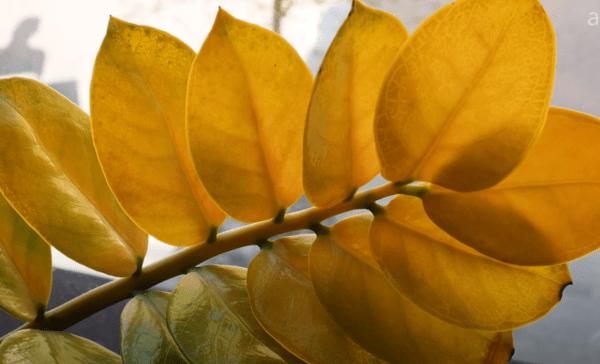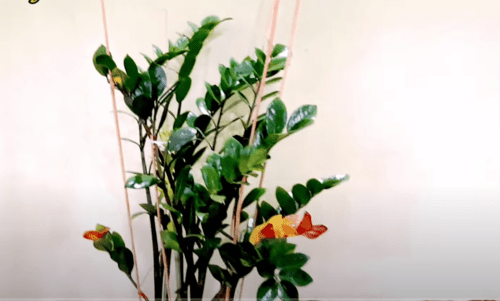Zamioculcas zamiifolia, sometimes known as the ZZ Plant, is noted for its adaptability and sleek, glossy green leaves. Due to its low maintenance requirements, it is a favorite among professionals and urban gardeners. However, even this hardy plant occasionally displays symptoms of distress, one of which is yellowing leaves. Let’s explore the many reasons for and effects of yellow leaves in ZZ Plants.

1. Overwatering: The Most Pervasive Offender
Reasons: ZZ Plants are drought-tolerant since they evolved in dry environments. They have evolved to require little water to thrive. Root rot, which can result in yellowing leaves, can be brought on by an overly wet soil.
Symptoms:
Yellowing leaves: Especially if they’re mushy and squishy.
Stems that are becoming mushy, black, or dark brown are a sign of rot.
A musty or moldy odor in the soil is an indication of inadequate aeration and stagnant water.
Solution: Before watering again, make sure the soil is dry at least two inches down. If root rot has advanced, after removing the damaged roots, think about repotting the plant.
2. Insufficient Watering: A Less Frequently Occurring But Potential Cause
Although ZZ Plants can withstand dryness, chronic neglect can still be harmful to them.
Symptoms:
Unlike the soft yellow leaves produced by overwatering, these leaves are crisp and yellow.
The plant has a droopy aspect and seems less lively than normal. Establish a regular watering plan and make sure the soil has enough time to dry out between applications.
3. The Silent Enemy of ZZ: Direct Sunlight Exposure

Causes: ZZ Plants can withstand a variety of lighting situations, although direct sunshine, particularly in warm climes, can be harmful.
Symptoms:On the leaf’s exposed areas, there are burnt marks that are yellow or brown.
Leaf color that has faded: A washed-out look as opposed to the usual vivid green.
Move the ZZ Plant to a location with direct light for a solution. It should not be exposed to direct sunlight, especially during busy times.
4. Aging: The Inevitable Course of Nature
Causes: Older leaves naturally become yellow before dropping as they reach the end of their life cycle.
Symptoms: Older leaves that are fading are often those near the plant’s base.
New growth is still green, indicating overall plant health.
Solution: To promote new development and keep the plant looking good, regularly cut yellowed leaves.
5. Terrible Soil Conditions and Drainage
Causes: ZZ Plants require soil that drains properly. Too much moisture in the soil can smother roots and cause root rot.
Symptoms:Even days after being watered, the earth is still saturated. Yellow leaves: Combined with the odor of standing water.Use a well-draining soil mixture, especially one that has been supplemented with perlite or sand. Verify that pots have adequate drainage holes.

6. Unwanted Freeloaders are a pest.
While ZZ Plants are mostly pest-resistant, aphids, spider mites, or mealybugs can occasionally do them harm.
Symptoms:
Tiny critters on the bottom of leaves or stems are an obvious problem.
Aphids frequently leave behind a sticky residue.
Yellowing or even browning of the leaves in cases of severe infestations.
Use natural insecticides like neem oil or clean the leaves with soapy water as a solution. Inspect plants often to spot bugs early.
ZZ Plants (Zamioculcas zamiifolia) Yellow Leaves: Expert Treatment Table
| Cause of Yellowing | Symptoms | Expert Medicinal Treatment |
| Root Rot | – Mushy, blackened roots<br>- Stagnant water smell from soil | – Trim affected roots<br>- Repot with fresh, well-draining soil<br>- Apply systemic fungicide if necessary |
| Sunburn | – Yellow or brown leaf spots<br>- Faded leaf color | – Relocate to indirect sunlight<br>- Use sheer curtains to filter direct rays |
| Pests | – Visible bugs on leaves or stems<br>- Sticky residue on leaves | – Wipe with soapy water<br>- Apply neem oil<br>- Use insecticidal soaps |
| Nutrient Imbalance | – Yellowing leaves with green veins (possible iron deficiency) | – Use balanced, water-soluble fertilizer<br>- Check and adjust soil pH |
| Temperature & Humidity | – Droopy appearance<br>- Crisp leaf edges | – Maintain stable temperature<br>- Use a humidifier or water-filled tray |
| Natural Leaf Aging | – Older leaves at the base turning yellow | – Regularly prune yellowed leaves to encourage new growth |
ZZ Plant Yellow Leaves: Expert FAQ Guide
1. Why are my ZZ Plant’s leaves turning yellow?
Several factorsi including overwatering, underwatering too much, direct sunlight, pests, natural aging, or a combination of these factors, can result in yellowing leaves.
2. Is ZZ Plant overwatering a common problem?
Yes, one of the most common causes, of yellow leaves in ZZ Plants is overwatering. They have rhizomes that store water and are drought-tolerant. Root rot one of the main causes of yellowing leaves, can be brought on by overly wet soil.
3. How can I tell if I’ve given my ZZ Plant too much water?
Verify for:mushy, soft yellow leaves. a musty, stagnant odor coming from the soil.
stems that are black or dark brown, indicating rot.
4. Can my ZZ Plant be harmed by direct sunlight?
ZZ Plants can grow, in a range of lighting conditions, but prolonged exposure to the sun’s rays can result in brown or yellow sunburnt spots on the leaves.
5. What pests, could be to blame for the yellow leaves on my ZZ Plant?
ZZ Plants are generally, pest-resistant, but aphids, spider mites, and mealybugs can occasionally cause them problems. These pests can put the plant under stress, causing the leaves to yellow.
6. How do I take care of a pest-infested ZZ plant?
Think about using homemade remedies like rubbing leaves in a solution of soapy water. Use natural remedies instead such as neem oil sprays. To stop the spread of pests, always isolate the affected plant.
7. The older leaves on my ZZ plant are turning yellow. Is this standard?
Yes, older leaves particularly those at the base will eventually, turn yellow and drop off. It is a stage in the natural life cycle of the plant. The plant’s appearance can be preserved with regular pruning.
8.How frequently should I water my ZZ Plant in order to avoid having yellow leaves?
The environment determines how often to water. But it’s typically advised to wait until the top 2 inches of soil have dried out before watering again. For ZZ Plants, overwatering can be more detrimental than underwatering.
9. Can ZZ Plants develop yellow leaves due to, nutrient deficiencies?
Yes, a deficiency in vital nutrients, can cause leaves to yellow. A well-rounded, water-soluble fertilizer can assist in solving this. However, in order to prevent over fertilization, always use the recommended dosage.
10. Despite addressing potential causes the leaves on my, ZZ Plant are still yellow. Now what?
Think about variables like soil pH, or temperature swings. If all else fails, ask local horticulturists, or nurseries for guidance. Occasionally, a new viewpoint, can highlight a problem that has gone unnoticed.
